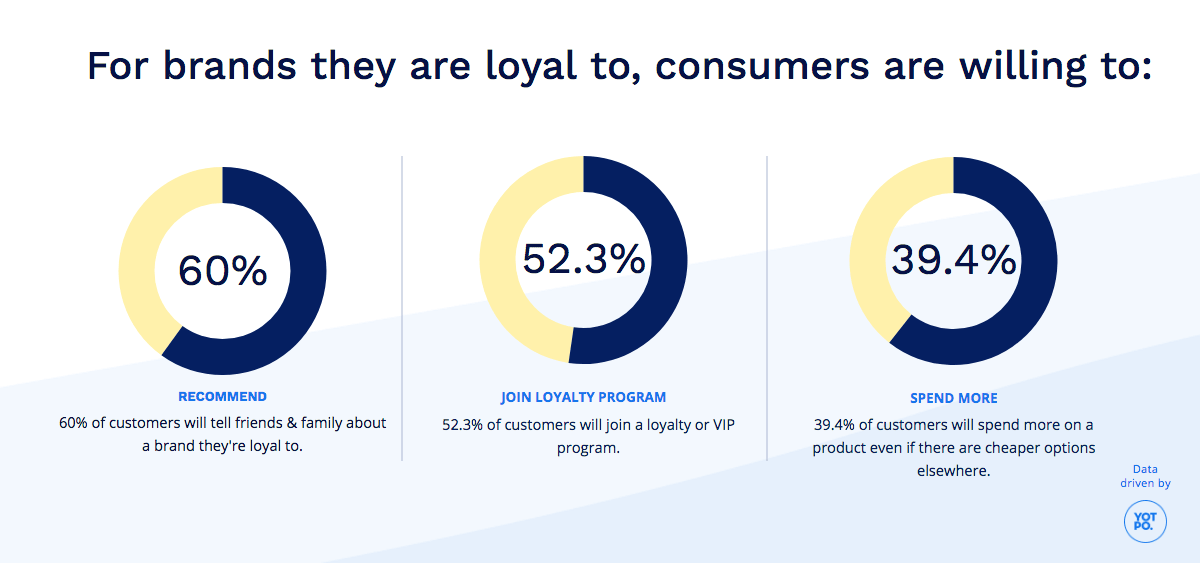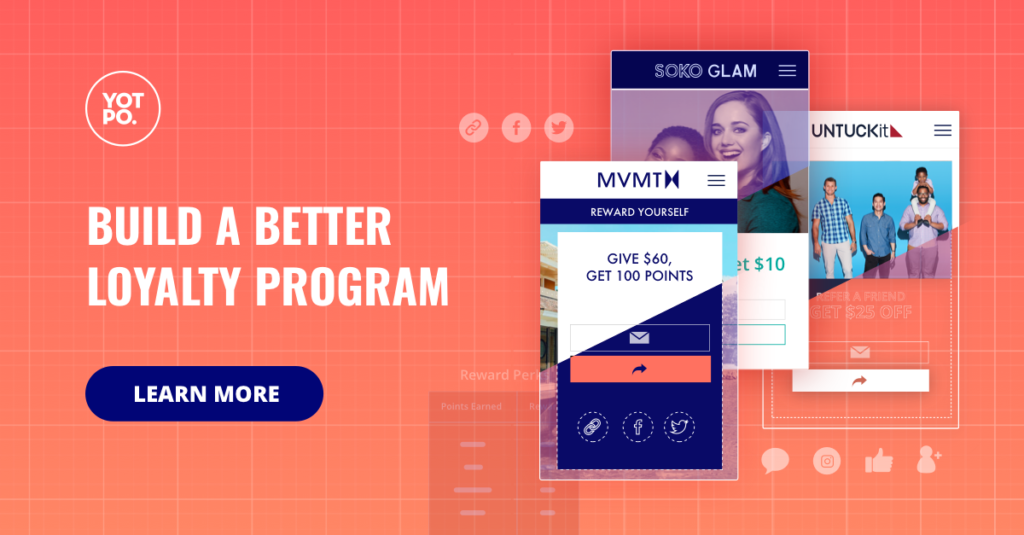Today’s shoppers have endless choice and frequently move between different brands. So, in order to succeed, brands need more than a great product and unique marketing plan to stand out; they need to build an emotional connection with their shoppers and to invest in customer loyalty.
Since existing customers spend 67% more than new customers, and new customers referred by your loyal customers have a 25% higher lifetime value than any other shoppers — there’s no question as to why eCommerce stores are investing in customer loyalty and referrals as a key marketing strategy.
With that in mind, this post will share the top customer loyalty trends and explain how can you build a successful loyalty program for 2019.
Why loyal customers are worth the effort
When customers are loyal to a brand, they’ll go the extra mile. Data shows that 60% of customers will tell their friends and family about a brand they are loyal to, creating free word-of-mouth marketing.

So, how can you build a customer loyalty strategy that works? Here are the loyalty strategies to keep in mind for 2019:
5 loyalty program trends you need to implement
Customers should have an emotional connection to your brand. Your marketing initiatives should remind customers of your values, your mission, and your story.
A loyalty program is one of the best ways to express your brand mission and values and put them in action. Customers favor loyalty programs that reward for activities other than purchasing. This way, your consumers feel they are contributing to something they believe in.
How can you implement this in your program?
- Set up custom campaigns to offer incentives for unique desired actions. Some of our favorite brands have campaigns for contributing to a social cause, participating in fitness activities, taking an action for the environment, etc.
Customers want to be recognized personally on all channels. They want a message that’s tailored to them, using their name, and including product recommendations based on what interests them. Most of all, they want to feel appreciated.
In fact, a recent study of consumers in the US shows that 69% of shoppers say acknowledging a customer’s loyalty and importance is a key metric for deciding which brands they are loyal to.
How can you implement this in your program?
- Integrate your ESP (email service provider) to your loyalty program to enjoy customer attributes in e-mail marketing, including total number of points, referral information, next redemption, etc.
- Segment customers by VIP tiers to show your appreciation.
An on-brand and unified experience ultimately contributes to higher customer engagement. Your customers should get a sense of your brand in every interaction they have. Your loyalty program is a great way to push for a consistent and seamless experience from the discovery stage all the way through checkout. Investing in this will result in a faster route to checkout and increased brand advocacy.
How can you implement this in your program?
- Create a dedicated rewards and referrals page on your site with your brand look and feel. This creates a seamless experience for customers when looking to engage with your program and redeem their rewards.
- Create an easy-to-use program with minimal steps required to take actions and see value — no need to create an account, minimal steps to send a referrals etc.
Since 81% of US online shoppers’ purchase decisions are influenced by their friends, you know you need to invest in engaging with your customers so that your relationship is meaningful enough to share with the world. When shoppers feel passionate about a brand, that’s when they’ll start bringing it up with friends and family. And studies show that people referred by a friend are 4X more likely to buy than other shoppers.
A great experience, product, brand mission, and message alongside superior customer service is a start, but you should also ensure your natural brand ambassadors get value for their loyalty. With incentivized referrals you can build the natural habit of sharing in a way that benefits your customers as well as new potential shoppers.
How can you implement this in your program?
- Allow your customers to share referral links privately and personally with their friends. We’ve found that sharing with a friend directly through e-mail or facebook messenger works 15x than publicly sharing a referral link on social media. Consumers value a personal touch and one-to-one connection.
- Make it easy for your customers to spread the word to friends by enabling direct messaging and a seamless user experience.
Take a close look at your data. To succeed, you’ll need to understand your customers, their shopping behaviors and trends alongside their feedback and thoughts about your brand.
How can you implement this in your program?
- Use your loyalty program insights to tap into the personal experience of your individual customers, so you can build targeted communications and a personalized experience.
Conclusion
Customer loyalty is more important than ever. In order to succeed, brands need to build a unique loyalty program strategy that takes into consideration key elements of brand values, user experience, and ease of use for customers. Programs need to tell the story of your brand while still nurturing and building a trusting relationship with your customer — only then will our customers become loyal shoppers and brand ambassadors.















 Join a free demo, personalized to fit your needs
Join a free demo, personalized to fit your needs